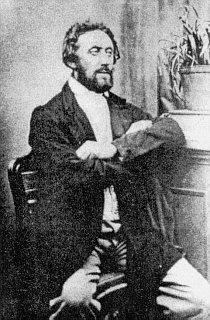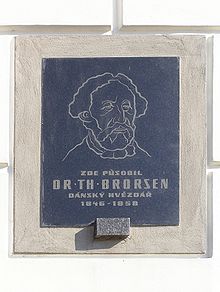Theodor Brorsen
Theodor Johann Christian Ambders Brorsen (born July 29, 1819 in Nordborg ; † March 31, 1895 ibid) was a Danish astronomer .
Life
Theodor Brorsen was born in Nordborg on the island of Alsen ( North Schleswig ) as the son of the captain Christian August Brorsen (1793-1840) and his wife Annette Margrethe Gerhardine Schumacher (1788-1855). He got his three middle names after his mother's maternal grandfather, the Nordborg judicial advisor Johann Christian Ambders (1710–1795), a grandson of pastor Andreas Ambders (1613–1687). Since his parents' divorce in 1822, Brorsen grew up with his mother. Their good financial circumstances allowed him to attend the school of the Brethren in Christiansfeld (1826–1829) after first lessons by private tutors and then until 1839 the Latin school in Flensburg . At his mother's request, Brorsen began studying law in Kiel (1839), Berlin (1840), Heidelberg (1841) and again Kiel (1842), but then gave in to his inclinations and studied astronomy in Kiel from 1844 .
In 1846 Brorsen worked at the astronomical observatory in Kiel, and in 1847 in Altona. He turned down the offer of a position at the “ Rundetårn ” (Round Tower) observatory in Copenhagen . Instead, he took a job at the private observatory of Baron John Parish in Senftenberg in Bohemia . In 1854 Brorsen applied unsuccessfully for the vacant director of the observatory in Altona. After the death of Baron Parish in 1858, his heirs demolished the observatory in Senftenberg and sold the instruments, although Brorsen had offered to continue working for free. Nevertheless, Brorsen stayed in Senftenberg for twelve more years and continued observing with his own instruments, but made no more major discoveries.
In 1870 he returned to his hometown Nordborg in North Schleswig , which had been Prussian since the German-Danish War in 1864 and then belonged to the German Empire from 1871 (until the vote in 1920) , which Brorsen disapproved of. In Nordborg in 1874 he moved into the house Løjtertoft 11, which is still preserved today, where he lived until his death. His half-sisters Amalie Petrine Brorsen (1832-1911) and Marie Jensen ran the household for him. In his years in North Borger, however, Brorsen hardly dealt with astronomy, but primarily with meteorology (including aurora observations ) and botany , especially orchid breeding.
Personally, Brorsen was an introverted character with fear of attachment. Twice he broke an engagement at the last minute (first with Louise Lassen from Sonderburg , then with Miss Bernkopf from Senftenberg) and therefore remained unmarried. It is also well documented that he exhibited idiosyncratic behavior in his last 25 years in Nordborg: he paid little attention to his clothes, let his hair grow long, and when his boots pinched him he cut holes in the appropriate places . Every day he bathed in the Oldenor, a lake near Nordborg; in winter he chopped a hole in the ice to do this. Brorsen died at the age of 75 and was buried on April 5, 1895 in the Nordborg cemetery, where his grave still exists today. It has been maintained by the city of Nordborg since 1950.
Discoveries
Brorsen discovered five comets : 1846 III, 1846 VII, 1847 V, 1851 III and 1851 IV. Two of them are named after him as periodic comets: Comet 1846 III is called Brorsen and comet 1847 V is called Brorsen-Metcalf ( Metcalf after its rediscoverer 1919). The former comet 5D / Brorsen (orbit period 5.46 years) has not been sighted after five orbits since 1879; Belonging to the Jupiter comet family, which often consists of short-lived comets , it probably no longer exists today. The second comet named after Brorsen 23P / Brorsen-Metcalf (orbital period 70.54 years, observed orbits in 1847, 1919 and 1989) belongs to the Halley comet family and is expected again in 2059. With the discovery of another comet (1850 II), an American astronomer, William Cranch Bond , Brorsen came to Cambridge, Massachusetts , six days earlier. Brorsen may also have discovered a seventh comet on March 16, 1854; however, this discovery could not be confirmed by other astronomers.
In 1850 Brorsen rediscovered the gas nebula at Zeta Orionis , NGC 2024 , now known as the "Flame Nebula" , which, however, had previously been discovered and described by Wilhelm Herschel in 1786 without Brorsen's knowledge . In 1856, Brorsen discovered the globular cluster in the constellation Snake , which was cataloged as NGC 6539 .
In 1854 Brorsen published the first systematic studies on the so-called counter-reflection of the zodiacal light , in which he also correctly explained the phenomenon. Brorsen was the first to describe that the zodiacal light encompasses the entire sky, because zodiacal light and counter-light are connected by a light bridge that is weakly visible under favorable conditions. Next examined Brorsen occultations and the proper motion of the fixed stars . As a calculating astronomer, he was particularly concerned with the perihelion of comet and planetary orbits .
Honors
For his first three comet discoveries, Brorsen received a gold comet medal from the Danish King Christian VIII ; the one awarded to him in 1846 is now exhibited in the State Museum in Sonderborg Castle. Brorsen was appointed a corresponding member of the Natural History Association in Senftenberg in 1850.
In his hometown Nordborg today a street ( Th. Brorsens vej ) is named after Brorsen. The asteroid 3979 , November 8, 1983 by Antonín Mrkos discovered in Kleť was on a proposal by Jana Ticha "Brorsen" called (MPC 27734-1996 August 28).
literature
- Sven Houmøller, Otto Kryck: Families Brorsen fra Nordborg. Copenhagen 1949, pp. 25-28 (with older literature).
- Hertha Raben Petersen: Theodor Brorsen. Astronomer. HC Lorenzen, Nordborg 1986, ISBN 87-88558-053 .
- Entry in Dansk biografisk leksikon (Danish)
supporting documents
- ↑ Petersen, Brorsen , pp. 16f., 21.
- ↑ Petersen, Brorsen , pp. 22f., 25.
- ↑ Petersen, Brorsen , pp. 36, 39, 41.
- ↑ Petersen, Brorsen , pp. 42, 44, 46.
- ↑ Petersen, Brorsen , p. 48.
- ↑ Petersen, Brorsen , p. 68.
- ↑ Petersen, Brorsen , p. 77.
- ↑ Petersen, Brorsen , p. 81.
- ↑ Petersen, Brorsen , pp. 48–51.
- ↑ Petersen, Brorsen , pp. 78-80.
- ↑ Petersen, Brorsen , p. 83.
- ^ Philipp Carl: Repertorium Der Cometen-Astronomie . Munich 1864, p. 250; Petersen, Brorsen , p. 64.
- ↑ Petersen, Brorsen , pp. 65, 89.
- ^ Theodor Brorsen: Excerpts from letters from the observator Th. Brorsen to the editor , in: Astronomische Nachrichten 32 (1851), pp. 105–110.
- ^ Theodor Brorsen: Discovery of a new nebula , in: Conversations in the areas of astronomy, geography and meteorology 10 (1856), p. 292.
- ↑ in: Weekly Conversations for Astronomy , 1854; Brief summary: About the counter-reflection of the zodiacal light , in: Astronomische Nachrichten 42 (1855), pp. 219f. on-line
- ↑ August Svedstrup: Brorsen, Theodor , in: Dansk biografisk leksikon , Vol. 3, Copenhagen 1889, p. 121f., Here p. 122.
- ↑ see here ( Memento of the original from March 1, 2012 in the Internet Archive ) Info: The archive link has been inserted automatically and has not yet been checked. Please check the original and archive link according to the instructions and then remove this notice.
- ↑ Asteroid Brorsen in the JPL Small-Body Database Browser
Web links
- Publications by Brorsen in the Astrophysics Data System
- image
- Biography in Czech
- Images of Comet Brorsen-Metcalf
- Cometography by 5D / Brorsen
| personal data | |
|---|---|
| SURNAME | Brorsen, Theodor |
| ALTERNATIVE NAMES | Brorsen, Theodor Johann Christian Ambders (full name) |
| BRIEF DESCRIPTION | Danish astronomer |
| DATE OF BIRTH | July 29, 1819 |
| PLACE OF BIRTH | Nordborg |
| DATE OF DEATH | March 31, 1895 |
| Place of death | Nordborg |


